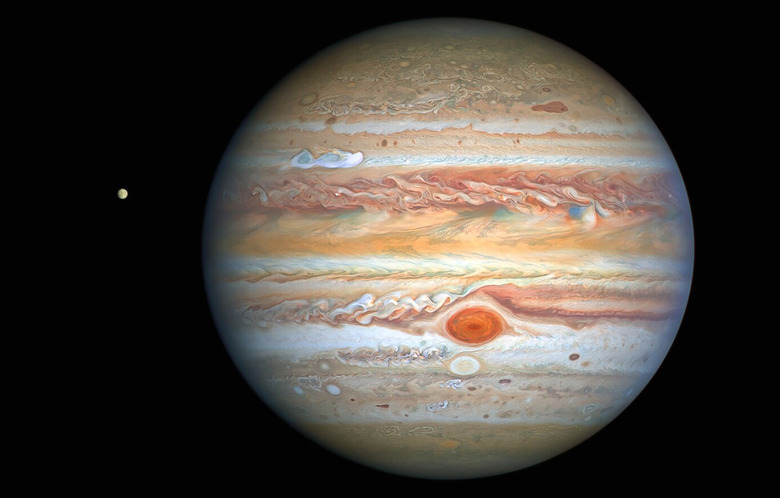This Hubble Photo Might Be Its Best Ever
- The Hubble Space Telescope has captured an absolutely stunning image of Jupiter.
- The image shows a multitude of storms and even the icy moon Europa hanging out in the background.
- Jupiter's storms are going through significant changes, and scientists can't explain why.
The Hubble Space Telescope may be getting old, but it still manages to capture some of the most gorgeous images of the cosmos that mankind has ever laid eyes on. Now, it's set its powerful sights on Jupiter and the resulting image is, well, one of its best photos ever, and that's saying a lot.
The image has everything you'd want from a snapshot of our system's mighty gas giant. There's the Great Red Spot, the smaller white spot, an all-new storm that is new to scientists, the turbulent swirling gasses, and even a photobomb from Europa hanging out int he background. It's just plain perfect.
So, let's address the biggest thing first: The Great Red Spot is looking nice and strong. That's interesting news, especially since earlier reports suggested the storm may be in the midst of dying and could even disappear within our lifetimes. That still may be true, but it sure looks incredible in this particular snapshot.
The smaller white spot beneath it is another raging storm, not quite the size of the red spot, but impressive nonetheless. And then if you look to the upper right of the planet's sphere you'll see a strange blob-like shape that is yet another storm, but this one is entirely new.
The Hubble team explains:
"A unique and exciting detail of Hubble's new snapshot appears at mid-northern latitudes as a bright, white, stretched-out storm moving at 560 kilometres per hour. This single plume erupted on 18 August 2020 and another has since appeared."
It's a fast-growing, fast-moving storm that is definitely worth keeping an eye on. The Hubble group says that storms appear in this spot on the planet from time to time, but this particular storm is more structured, which could mean that it will grow larger and last longer than its predecessors. Only time will tell.
As for the Great Red Spot's size, the Hubble team says that it's still big enough to swallow Earth whole, and that "its rate of shrinkage appears to have slowed." Adding that "the reason for its dwindling size is a complete mystery."
The white spot, or "Oval BA" is also evolving in interesting new ways:
Researchers are noticing that another feature has changed: the Oval BA, nicknamed by astronomers as Red Spot Jr., which appears just below the Great Red Spot in this image. For the past few years, Red Spot Jr. has been fading in colour to its original shade of white after appearing red in 2006. However, now the core of this storm appears to be darkening to a reddish hue. This could hint that Red Spot Jr. is on its way to reverting to a colour more similar to that of its cousin.
All of this information from a single, gorgeous image. Hubble, you've truly outdone yourself this time.
